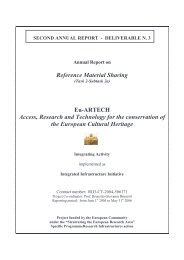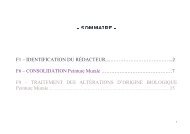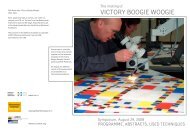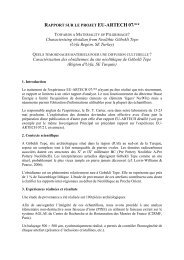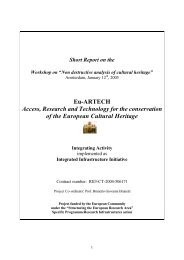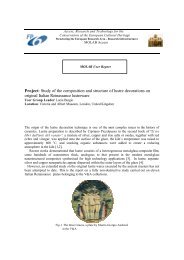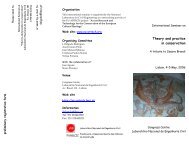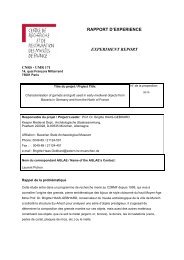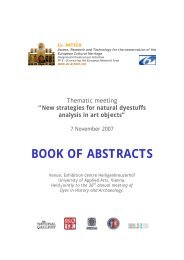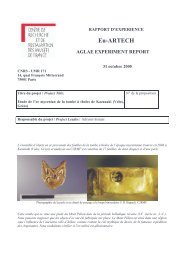Analytical strategies for dyestuffs - Eu-ARTECH
Analytical strategies for dyestuffs - Eu-ARTECH
Analytical strategies for dyestuffs - Eu-ARTECH
You also want an ePaper? Increase the reach of your titles
YUMPU automatically turns print PDFs into web optimized ePapers that Google loves.
FOURTH YEAR ANNUAL REPORT – DELIVERABLE N. 1<br />
N1. Task 2a- <strong>Analytical</strong> <strong>strategies</strong> <strong>for</strong> natural <strong>dyestuffs</strong> in cultural<br />
heritage objects<br />
(ICN)<br />
<strong>Eu</strong>-<strong>ARTECH</strong><br />
Access, Research and Technology <strong>for</strong> the conservation<br />
of the <strong>Eu</strong>ropean Cultural Heritage<br />
Integrating Activity<br />
implemented as<br />
Integrated Infrastructure Initiative<br />
Contract number: RII3-CT-2004-506171<br />
Project Co-ordinator: Prof. Brunetto Giovanni Brunetti<br />
Reporting period: from June 1 st 2004 to May 31 st 2005<br />
Project funded by the <strong>Eu</strong>ropean Community<br />
under the “Structuring the <strong>Eu</strong>ropean Research Area”<br />
Specific ProgrammeResearch Infrastructures action
N1. Task 2a - <strong>Analytical</strong> <strong>strategies</strong> <strong>for</strong> natural <strong>dyestuffs</strong> in<br />
cultural heritage objects<br />
(Resp. ICN)<br />
The results obtained <strong>for</strong> each dyestuff on wool and silk and as a pigment are discussed briefly<br />
under the appropriate heading. Some general points should also be noted. First of all, it is<br />
important to be aware that the results obtainable by chromatographic methods of analysis,<br />
used by most of the participating laboratories, and by 3-dimensional fluorescence<br />
spectroscopy, used by only two (UNI-PG and KIK/IRPA) are very different in kind.<br />
Chromatographic methods require a small sample to be taken from the object under study. 3dimensional<br />
fluorescence spectroscopy has the advantage that it is non-invasive: no sampling<br />
is necessary and a degree of distinction between <strong>dyestuffs</strong>, or classes of dyestuff, can be<br />
made, but the detailed qualitative and quantitative in<strong>for</strong>mation on the composition of the<br />
colouring matters present on the object, which chromatographic methods can provide, cannot<br />
be obtained by this technique.<br />
HPLC-PDA<br />
As high-per<strong>for</strong>mance liquid chromatography (HPLC) is a separation technique, the dyestuff<br />
constituents present in the sample of textile, paint or other material can be detected<br />
individually. This allows a more or less precise identification of the dyestuff to be made,<br />
based on the UV-visible (or other) characteristics of the individual components and their<br />
retention times: that is, on a characteristic pattern of constituents observable <strong>for</strong> that colouring<br />
matter. Identification can thus be made, even though the identities of some of the constituents<br />
of the colouring matter may be unknown, and quantitative estimates of the amounts of each<br />
constituent present can be obtained.<br />
Each of the participating laboratories has chosen chromatographic conditions – that is,<br />
eluents, gradients, column type and so on – in response to the requirements of the works of<br />
art, and thus the samples, usually studied there and the questions generally posed. The<br />
conditions commonly used <strong>for</strong> dyestuff analysis were originally applied to the examination of<br />
dyes on textiles, in particular anthraquinone dyes, like those from cochineal and madder, 1 but<br />
have subsequently been applied to the examination of other dyestuff classes and other types of<br />
art object. Improvements or modifications have been made according to the needs of the<br />
institution and as other column types or eluents have been tried and other aspects of the<br />
method varied, often following a published method. Thus, <strong>for</strong> example, the column used in all<br />
cases contains a reversed phase C18 packing of ODS2 type, but the precise packing and<br />
column type chosen, the particle size, column diameter, and thus the flow rate and time taken<br />
to complete the gradient used by each laboratory is different (<strong>for</strong> details see the protocols <strong>for</strong><br />
each laboratory). Both KIK/IRPA and NMS use a water/ methanol/ phosphoric acid gradient;<br />
KIK/IRPA uses a 125 x 4 mm column (5 µm particle size packing), while that used by NMS<br />
1 J. Wouters, ‘High per<strong>for</strong>mance liquid chromatography of anthraquinones: analysis of plant and insect extracts<br />
and dyed textiles’, Studies in Conservation 30 (1985), pp. 119–28.
is 150 x 4.6 mm (same particle size packing, different make). 2 ICN follows a similar method<br />
except that a 150 x 2 mm column (3.2 µm particle size packing) is preferred. 3 GCI uses the<br />
same basic conditions, replacing the phosphoric acid with <strong>for</strong>mic acid as phosphoric acid<br />
cannot be used <strong>for</strong> LC–MS; they use a 100 x 2 mm column (3 µm particle size packing).<br />
OADC follows a different published method in which a binary water/ acetonitrile eluent<br />
system is used, adding 0.1% trifluoroacetic acid to each of the eluents; they use a 250 x 3 mm<br />
column (5 µm particle size packing). 4 NGL uses a similar eluent system to OADC (with an<br />
addition of 5% methanol to the acetonitrile), but with a 150 x 0.5 mm column (5 µm particle<br />
size packing) and thus a slower flow rate and considerably longer run time than the other<br />
laboratories. 5<br />
Comparison of the results obtained by the participating laboratories shows that these different<br />
chromatographic conditions may affect the quality of chromatic separation of the components,<br />
but have only a minor influence on the analytical results themselves; the method of dyestuff<br />
extraction, however, has a significant effect. Most of the partners (and most laboratories<br />
working on the examination of natural dyes in the conservation field) use acid hydrolysis<br />
(HCl/methanol/water, 2:1:1) <strong>for</strong> the extraction of red and yellow <strong>dyestuffs</strong>, a procedure first<br />
developed in the 1980s. 6 The extraction is quite efficient and gives clear-cut, easily<br />
quantifiable results, but because O-glycosides and carboxylic acids are hydrolysed,<br />
in<strong>for</strong>mation on the possible presence of such constituents on the textile or in the pigment may<br />
be lost. For example, pseudopurpurin (1,2,4-trihydroxyanthraquinone-3-carboxylic acid) and<br />
purpurin (1,2,4-trihydroxyanthraquinone) may both be present in madder dye, but as<br />
pseudopurpurin is converted to purpurin on acid hydrolysis, in<strong>for</strong>mation on its possible<br />
presence is lost.<br />
One laboratory (NGL) uses the methylating agent boron trifluoride/methanol at a dilution of<br />
4% to extract the dyestuff. This method was devised to obtain a more efficient extraction of<br />
dyestuff from a lake pigment bound in paint medium than was usually possible with acid<br />
hydrolysis and was first used <strong>for</strong> thin-layer chromatography of anthraquinone and soluble<br />
redwood dyes in the mid-1970s, although not published<br />
until later. 7 The paint medium is broken up by the reagent, which also breaks up the lake<br />
pigment, releasing the dyestuff into the solution. The method has disadvantages: some<br />
methylation of susceptible groups (present in carboxylic acids, <strong>for</strong> example) takes place and<br />
the reaction is not quantitative (side reactions may occur). Extraction of the dye from textiles<br />
may be less efficient than the acid hydrolysis method. The chromatograms obtained are more<br />
complex than those obtained using acid hydrolysis and it is less easy to make quantitative<br />
estimates of constituents present. On the other hand, decarboxylation does not occur and, once<br />
allowance <strong>for</strong> any methylation has been made, the pattern of constituents observed reflects the<br />
actual composition of the colouring matter on the textile or in the pigment to a large extent, as<br />
in<strong>for</strong>mation on glycosides and carboxylic acids is retained. As an added benefit, some<br />
2 J. Wouters and N. Rosario-Chirinos, ‘Dye analysis of pre-Columbian Peruvian textiles with high-per<strong>for</strong>mance<br />
liquid chromatography and diode-array detection’, Journal of the American Institute <strong>for</strong> Conservation 31 (1992),<br />
pp. 237–55.<br />
3 M.R. van Bommel, ‘The analysis of dyes with HPLC coupled to photodiode array and fluorescence detection’,<br />
Dyes in History and Archaeology 20 (2001), pp. 30–38.<br />
4 S.M. Halpine, ‘An improved dye and lake pigment analysis method <strong>for</strong> high-per<strong>for</strong>mance liquid<br />
chromatography and diode-array detector’, Studies in Conservation 41 (1996), pp. 76–94.<br />
5 J. Kirby, M. Spring and C. Higgitt, ‘The technology of eighteenth- and nineteenth-century red lake pigments’<br />
National Gallery Technical Bulletin 28 (2007), pp. 69–87, see note 70, p. 86.<br />
6 Wouters 1985 (cited in note 1).<br />
7 J. Kirby and R. White, ‘The identification of red lake pigment <strong>dyestuffs</strong> and a discussion of their use’, National<br />
Gallery Technical Bulletin 17, 1996, pp. 56–80.
in<strong>for</strong>mation on the technology of dyeing the textile or preparing the lake pigment may thus be<br />
gained. Pseudopurpurin, <strong>for</strong> example, is partly or fully converted to a methylated <strong>for</strong>m, but it<br />
is clearly identifiable separately to any purpurin that that the dyestuff sample may contain. In<br />
practice it has been found that the two extraction methods complement each other very well.<br />
Other extraction methods that have been applied to samples of dyed textiles or pigments<br />
include the use of the complexing agent EDTA (ethylenediaminetetraacetate, disodium salt)<br />
with or without the aid of hydrochloric acid or other solvents, 8 <strong>for</strong>mic acid 9 and hydrofluoric<br />
acid, 10 but only a very small-scale study of these was made (by ICN) as part of the pilot<br />
project on the weld dye (q.v.). Acetic acid is sometimes used <strong>for</strong> samples of dyed textile when<br />
the presence of an acid-sensitive dye is suspected (ICN).<br />
A comparison of the results obtained by each laboratory <strong>for</strong> any one dyestuff will also show<br />
that, allowing <strong>for</strong> the fact that some of the dyestuff constituents have not yet been identified at<br />
all, some laboratories were able to identify more constituents of the dyestuff than others. This<br />
reflects the fact that not all laboratories have access to detailed analytical in<strong>for</strong>mation on the<br />
constituents (by mass spectrometric analysis, <strong>for</strong> example) or to samples of them as pure<br />
chemicals: many are not commercially available and those that can be purchased are often<br />
very expensive. From this point of view, the inter-laboratory comparison exercise has been<br />
very valuable <strong>for</strong> the laboratories taking part, as it helps each laboratory to identify some<br />
components on which it has no in<strong>for</strong>mation by comparison of its results with those obtained<br />
by the other partners.<br />
All the laboratories use photo-diode array (PDA) detection; this enables a UV-visible<br />
spectrum of each constituent to be produced so that constituents can be identified by this<br />
means and by retention time. Some laboratories (OADC, GCI and NMS with the University<br />
of Edinburgh) are able to examine the components separated by HPLC by mass spectrometry,<br />
giving molecular in<strong>for</strong>mation and the possibility of confirmation or identification of<br />
constituents.<br />
3-D fluorescence spectroscopy<br />
The non-destructive technique of 3-dimensional fluorescence spectroscopy as applied to the<br />
characterisation or identification of natural dyes is still relatively new. 11 The fluorescence<br />
characteristics of the dyestuff are observed at defined excitation and emission wavelengths,<br />
taking account of both emission and excitation spectra. It is also necessary to take account of<br />
possible fluorescence from the substrate itself (textile fibre, parchment, paper and so on); it<br />
was found, <strong>for</strong> example, that the results obtained from the same dyestuff on silk, on wool and<br />
8 E.J. Tiedemann and Y. Yang, ‘Fiber-safe extraction of red mordant dyes from hair fibers’, Journal of the<br />
American Institute <strong>for</strong> Conservation 34 (1995), pp. 195–206; X. Zhang and R.A. Laursen, ‘Development of mild<br />
extraction methods <strong>for</strong> the analysis of natural dyes in textiles of historical interest using LC-diode array detector-<br />
MS’, <strong>Analytical</strong> Chemistry 77 (2005), pp. 2022–5.<br />
9 Zhang and Laursen 2005 (cited in note 8).<br />
10 J. Sanyova and J. Reisse, ‘Development of a mild method <strong>for</strong> the extraction of anthraquinones from their<br />
aluminum complexes in madder lakes prior to HPLC analysis’, Journal of Cultural Heritage 7 (2006), pp. 229–<br />
35.<br />
11 S. Shimoyama and Y. Noda, ‘Non-destructive determination of natural <strong>dyestuffs</strong> used <strong>for</strong> ancient coloured<br />
cloths using a three-dimensional fluorescence spectrum technique’, Dyes in History and Archaeology 12 (1993),<br />
pp. 45–56; C. Clementi, C. Miliani, A. Romani and G. Favaro, ‘In situ fluorimetry: a powerful non-invasive<br />
diagnostic technique <strong>for</strong> natural dyes used in artefacts. Part I: Spectral characterization of orcein in solution, on<br />
silk and wool laboratory-standards and a fragment of Renaissance tapestry’, Spectrochimica Acta Part A 64<br />
(2006), pp. 906–12; C. Clementi, B. Doherty, P. L. Gentili, C. Miliani, A. Romani, B.G. Brunetti and A.<br />
Sgamellotti, ‘Vibrational and electronic properties of painting lakes’, Applied Physics A (2008), in press.
as a pigment differed slightly. Initially it was also found more difficult to obtain results from<br />
pigment powders due to the irregularity of the surfaces; this can be resolved by careful<br />
selection of filters, which also enhances reproducibility and specificity of the technique.<br />
Another approach is taken by KIK by using the 3 dimensional excitation-emission plot as a<br />
first screening plot to select the area(s) of fluorescence. In this phase, it is chosen to use<br />
always a systematically gradually change of excitation and emission filters depending on the<br />
excitation wavelength during the multi-scan, in order to minimise the risk of loosing<br />
fluorescence signals in unknown samples because of different filter selection. In a second<br />
step, one or more single line scans are done at the most suitable excitation wavelengths as<br />
detected out of the 3D-plot, using filter selection if necessary to optimise the emission profile.<br />
The pattern of fluorescence observed is <strong>for</strong> the dyestuff as a whole; the contributions of<br />
individual constituents cannot generally be monitored. Thus, as far as the red dyes were<br />
concerned, it is possible to distinguish between samples containing cochineal dyestuff (from a<br />
scale insect source) and the vegetable dyes, madder, safflower and sappanwood; it is more<br />
difficult to determine the source of the yellow dyes (dyer’s broom and weld), both of which<br />
contain luteolin among other constituents. It is possible to say, however, that the dye is of a<br />
flavonoid type. It is particularly interesting that it is possible identify the presence of<br />
chlorophyll A in the textiles dyed with dyer’s broom and weld (where these were examined)<br />
and the lakes with a calcium-containing substrate, but not in the lakes with a substrate of<br />
hydrated alumina; chlorophyll A was not identified by any of the laboratories using<br />
chromatographic systems.
Weld – the pilot project<br />
Weld was used <strong>for</strong> the pilot project, thus the dyeing of wool and silk, the preparation of the<br />
pigments and the subsequent analyses were treated in some depth so that the partner<br />
laboratories were able to assess and compare different methods of examination be<strong>for</strong>e<br />
extending the survey to the other dyes studied. The recipes used to prepare the textile and<br />
pigment samples using weld were subsequently used <strong>for</strong> dyer’s broom; these two plant dyes<br />
are very similar, both containing the flavonoids luteolin and apigenin as the principal<br />
colouring matters, and may present problems during analysis.<br />
3-D fluorescence spectroscopy<br />
Using an excitation wavelength of 366 nm, one emitting species with λmax 550 nm was<br />
detected by 3-D fluorescence spectroscopy in weld lakes 1 and 2; this emission is, in fact,<br />
independent of the excitation wavelength and is characteristic of flavonoids, according to the<br />
Perugia laboratory database. In addition, an emission at around 670 nm, with a weak shoulder<br />
at about 720 nm indicated the presence of chlorophyll A, identified by comparison with the<br />
emission, excitation and absorption spectra of chlorophyll A and B standards. Weld lake 3<br />
showed the flavonoid emission maximum at 525 nm and no chlorophyll could be detected.<br />
Weld lake 3 contains a <strong>for</strong>m of amorphous hydrated alumina as substrate, whereas lakes 1 and<br />
2 contain a high proportion of calcium carbonate, with some calcium sulphate and a little<br />
amorphous hydrated alumina.<br />
Chlorophyll, with absorption and emission of fluorescence at much the same wavelengths as<br />
in the lakes, was also detected on the silks (a relatively narrow emission at about 675 nm with<br />
a shoulder at 725 nm) and to a lesser extent on the wool (about 670 nm; no shoulder visible).<br />
In the case of the flavonoid emission, the fluorescence maxima were at slightly lower values<br />
<strong>for</strong> the silk than <strong>for</strong> the wool: 520 nm <strong>for</strong> weld on wool, but 501 nm <strong>for</strong> weld on silk, both at<br />
an excitation wavelength of 360 nm. The addition of potash to the dye-bath caused a shift of<br />
the flavonoid emission to longer wavelengths: 552 nm in the case of the wool; the shift is<br />
rather greater in the case of wool than it is with silk, suggesting that the interaction between<br />
the dye and the fibre is somewhat different in the two textiles. In the case of the silk dyed in<br />
the presence of potash, more than one emitting species appeared to be present in the 510–540<br />
nm wavelength range. The textiles are a markedly different, brighter yellow colour when<br />
potash is present in the dye-bath.<br />
Although emission curves differ when using the second method (KIK), because of the<br />
measurement at other excitation wavelengths and the use of eventually other filters, the<br />
general outcome is in the same line. The shift towards longer wavelengths is found in the<br />
potash dye baths as well, while chlorophyll was found in the silks samples, however not in<br />
wool.<br />
HPLC-PDA<br />
All laboratories using acid hydrolysis to extract the dyestuff detected the presence of luteolin<br />
and apigenin on the textiles and in the lakes, together with many small components with UVvisible<br />
spectra similar to that of luteolin; the results obtained were very similar. The precise<br />
ratio of luteolin to apigenin present depended on the sample (95:5 to 86:13). A late-eluting<br />
component with a UV/visible spectrum very similar to that of luteolin was seen by all the
partners; NMS, with the University of Edinburgh, were able to identify this as a luteolin-7methyl<br />
ether by MS and NMR. KIK/IRPA reported the presence of a late-eluting component,<br />
λmax c. 420 nm, not observed in these samples by other participants.<br />
NGL, using boron trifluoride methanol as the extraction agent, detected several luteolin and<br />
apigenin glycosides in the pigments, eluting be<strong>for</strong>e luteolin, apigenin and the luteolin-7methyl<br />
ether. The approximate average proportions of glycoside to aglycone were 68:32 (lake<br />
1), 46:54 (lake 2) and 74:26 (lake 3); a sample taken from a boiled aqueous extract of weld,<br />
typical of that used <strong>for</strong> pigment preparation, contained 67% glycoside to 33% aglycone; these<br />
values will, of course, depend on whether or not any enzymatic breakdown of the glycosides<br />
takes place (if, <strong>for</strong> example, the plant matter is allowed to soak <strong>for</strong> any length of time) and<br />
various other factors dependent on the recipe used. The most important glycosides present<br />
were luteolin-7-glucoside and luteolin-3',7-diglucoside; apigenin-7-glycoside and several<br />
other unidentified luteolin- or apigenin-related glycosides were also detected. It is likely that<br />
some of the minor peaks observed in chromatograms after HCl hydrolysis are residual traces<br />
of these glycosides; if the sample is large and insufficient acid is used only partial hydrolysis<br />
takes place.<br />
NGL also found that the glycosides were present on the textiles, although there was not much<br />
luteolin-3',7-diglycoside. In the dyed silk samples, more glycoside was present if potash had<br />
been used in the dye-bath, about 49% glycoside to 51% aglycone; a marked amount of<br />
luteolin-7-glycoside was detected, as well as luteolin, apigenin and luteolin-7-methyl ether. In<br />
the absence of potash, far more aglycone was present on the textile: 28% glycoside by<br />
comparison with 72% aglycone. The pattern with wool was very similar, although the<br />
difference was less dramatic: 36% glycoside to 64% aglycone in the presence of potash, 25%<br />
glycoside to 75% aglycone when potash was absent. This may be explained by suppression of<br />
enzymatic hydrolysis of the glycosides or some influence on the take-up of dye by the textiles<br />
in alkaline conditions, but further investigation of the dye-baths is necessary be<strong>for</strong>e any<br />
conclusion can be reached.<br />
Of the other methods of extraction investigated by ICN, <strong>for</strong>mic acid did not cause as much<br />
hydrolysis as the hydrochloric acid normally used, so that a mixture of glycosides and<br />
aglycones could be seen, but the extraction was very inefficient (33% or so). The complexing<br />
agent EDTA was even less effective, although quite good results were obtained from the weld<br />
samples at the Metropolitan Museum, New York using this reagent, revealing the presence of<br />
luteolin-7-glucoside on the textiles.<br />
Other methods of analysis<br />
Examination of the substrate <strong>for</strong> the lake pigments and the mordant <strong>for</strong> the textile fibres was<br />
carried out using the non-destructive method of X-ray fluorescence spectroscopy (XRF; UNI-<br />
PG); this method was able to identify the presence of calcium (Ca) and, in some cases,<br />
potassium (K), but the lighter element aluminium (Al) was not detected. Fourier trans<strong>for</strong>m<br />
infrared (FTIR) spectrometry and Raman spectroscopy were also carried out by UNI-PG,<br />
using a fibre optic system between the measuring head and the instrument; however, these<br />
were found to give more in<strong>for</strong>mation on the textile itself than on the mordant. UV-VIS<br />
colorimetry was carried out at UNI-PG and visible colorimetry at NGL; this characterises the<br />
colour of the textiles or pigments in terms of, <strong>for</strong> example, the CIE (Commission
Internationale d’Eclairage) L*a*b* colour space system, where L* is lightness, a* a measure<br />
of redness–greenness and b* a measure of yellowness–blueness. Energy dispersive X-ray<br />
microanalysis in the scanning electron microscope (SEM–EDX), which requires a small<br />
sample, was carried out at ICN and NGL; Al, Ca, K and other trace elements present were<br />
identified. FTIR microscopy could also be carried out on small samples at NGL and ICN, if,<br />
<strong>for</strong> example, it was desired to obtain more in<strong>for</strong>mation on the chemical nature of the substrate<br />
of the lake pigments.
Dyer’s broom<br />
The results should be compared with those obtained <strong>for</strong> weld as both dyes contain luteolin and<br />
apigenin; the important difference is the presence of the flavonoid genistein and its associated<br />
glycosides in dyer’s broom. The same recipes were used <strong>for</strong> dyeing and <strong>for</strong> lake pigment<br />
preparation, the only difference being that preparation of the pigment equivalent to weld lake<br />
2 (with a calcium/aluminium-containing substrate, very similar to that of weld lake 1) was<br />
omitted, hence there is no dyer’s broom lake 2.<br />
3-D fluorescence spectroscopy<br />
Dyer’s broom lake 1 showed an emission at 540 nm, a value independent of the excitation<br />
wavelength; by comparison with the Perugia laboratory database this is an emission<br />
characteristic of flavonoids. A weak emission at 659 nm with a shoulder at 715 nm is<br />
characteristic of chlorophyll A. Dyer’s broom lake 3, with a substrate of some variety of<br />
hydrated alumina, showed a flavonoid emission at 535 nm, but no chlorophyll could be<br />
detected. A similar pattern was seen with the weld lakes.<br />
A broad fluorescence emission at 479 nm on silk and 493 nm on wool at the excitation<br />
wavelength used, 360 nm, is characteristic of flavonoids, according to the Perugia laboratory<br />
database; as with weld, this emission is independent of the excitation wavelength. A band at<br />
673 nm (wool), 675 nm (silk) with a shoulder at 720 nm is characteristic of chlorophyll A,<br />
also as seen in weld; in the case of silk this band was sharp and quite marked. The use of<br />
potash in the dye-bath caused a shift in the flavonoid emission to 490 nm in the case of silk<br />
and 542 nm in the case of wool; this shift was greater in the case of wool, as seen with weld,<br />
and suggests the interaction between the dye and silk is different to that between the dye and<br />
wool. The chlorophyll emission was not affected by the presence of potash and the fact that<br />
the emission is higher on silk suggests the affinity of chlorophyll <strong>for</strong> the two fibre types is<br />
different; this is also seen with the weld dye.<br />
By the second FOFS method (KIK), chlorophyll is found again only in the silk samples.<br />
For both methods, the conclusion towards diagnostic outcome is the same: It is not possible to<br />
make a reliable distinction between the very similar <strong>dyestuffs</strong> extracted from dyer’s broom<br />
and weld by this technique.<br />
HPLC-PDA<br />
All the partner laboratories were able to identify the dyestuff from the presence of luteolin and<br />
genistein in all the lake and textile samples; apigenin was also identified in all samples. As<br />
several published sources suggest that apigenin is absent from this dyestuff, this is an<br />
important result. A luteolin-like component eluting after apigenin is likely to be a luteolin<br />
methyl ether (NMS/University of Edinburgh), as in weld, although not necessarily the same<br />
one, and there may be more than one. KIK/IRPA reported the presence of a late-eluting<br />
component, λmax 419 nm, similar to that observed in weld; this was not observed in these
samples by other participants and it is possible that this is due to differences in column<br />
per<strong>for</strong>mance between the systems used by the partners.<br />
All partners using acid hydrolysis to extract the dye observed small amounts of luteolin- and<br />
genistein-like constituents, probably traces of the glycosides observed by NGL using boron<br />
trifluoride/methanol. The glycosides detected by NGL included luteolin-7-glycoside with a<br />
similar retention time and an identical UV-VIS spectrum to that seen in weld, but with a<br />
different sugar attached, genistin, the principal glycoside of genistein and an apigenin-7glycoside.<br />
Genistin and the luteolin-7-glycoside overlap in the analytical system used at NGL,<br />
but it is easy to distinguish them (and also luteolin and genistein if this is necessary) by<br />
comparing chromatograms run at 254 nm and 330 nm: genistin and genistein are barely<br />
visible at 330 nm. In the lake pigments, further glycosides of genistein, luteolin and apigenin<br />
were detected, with a glycoside content of about 44% in lake 1 and 40% in lake 3. Little, if<br />
any, glycoside equivalent to the luteolin-3',7-diglucoside present in weld was detected in any<br />
of the samples; this may be a method to distinguish between the two <strong>dyestuffs</strong>. More luteolin<br />
was found to be present on both wool and silk dyed in the presence of potash than in that dyed<br />
without, but in all cases genistein and luteolin-7-glycoside were substantial components on all<br />
the textiles. Variable amounts of a large number of other luteolin, genistein and apigenin<br />
glycosides, or compounds with UV-VIS spectra similar to them, were detected. The most<br />
important was a genistein-related constituent with a UV-VIS spectrum similar to genistin, but<br />
with a longer retention time; after luteolin, genistein and luteolin-7-glycoside this was the<br />
largest constituent on the textiles (more than genistin). This was observed by all the partners<br />
as it was not destroyed by acid hydrolysis. It was not present (or was a very minor<br />
constituent) in the lakes, so it is possible that it is an artefact of the dyeing process.<br />
OADC also examined the samples by HPLC–MS. Luteolin (MW 284.2–284.3, depending on<br />
sample) was identified in all samples, together with genistein + apigenin (MW around 268.3:<br />
apparently these could not be separated). Other unidentified constituents were observed in<br />
lake 3 and the two silk samples.
Indigo<br />
Indigo dyestuff is used directly as a pigment; it is insoluble in the binding media commonly<br />
used <strong>for</strong> painting. There was thus no need to prepare any pigments.<br />
3-D fluorescence spectroscopy<br />
Using an excitation wavelength of 600 nm, a very broad fluorescence emission at 742 nm <strong>for</strong><br />
indigo on wool, 746 nm <strong>for</strong> indigo on silk was obtained. The emission intensity was very low,<br />
but it was found to be independent of the excitation wavelength, suggesting the presence of<br />
one emitting species.<br />
HPLC-PDA<br />
All the laboratories identified indigotin and indirubin on the indigo-dyed wool and silk, but as<br />
it is not possible at present to distinguish between indigo from species of Indigofera, woad<br />
(Isatis tinctoria L.), or any other plant source no more detailed identification can be made.<br />
Indirubin is frequently present in synthetic indigo so even this cannot be ruled out.<br />
Boron trifluoride/methanol is a very poor solvent <strong>for</strong> indigo, thus NGL obtained poor results<br />
<strong>for</strong> the two analyses, although the identifications of indigotin and indirubin could still be<br />
made and traces of several UV-absorbing compounds and one or two yellow constituents<br />
were also detected. ICN used dimethyl <strong>for</strong>mamide to extract the dyestuff and detected a range<br />
of constituents, including isatin (which could be a precursor or a breakdown product of<br />
indigotin), several absorbing in the UV region, two unknown yellow constituents and an<br />
unknown orange constituent. The remaining laboratories used the acid hydrolysis method<br />
described in their protocols. NMS also detected a range of other constituents, some UVabsorbing,<br />
others red and blue, but used a large sample volume to achieve this.<br />
OADC identified indigotin (MW 260.45) and traces of indirubin (MW 260.29) on the silk by<br />
HPLC–MS; only indigotin could be identified on the wool.<br />
The difficulties experienced with the analysis of indigo is likely to be due partly to poor<br />
extraction or to the use of chromatographic conditions not optimised <strong>for</strong> indigoid dyes. In<br />
practice the conditions used are frequently modified if indigoid dyes are to be examined (see,<br />
<strong>for</strong> example, J. Wouters and A. Verhecken, ‘High-per<strong>for</strong>mance liquid chromatography of blue<br />
and purple indigoid natural dyes’, Journal of the Society of Dyers and Colourists 107 (1991),<br />
pp. 266−9).
Cochineal<br />
Dyestuff extracted from the dyed silk prepared <strong>for</strong> the project was used to prepare the lake<br />
pigment. Alkaline extraction of the dye from shearings of textile dyed with kermes, the Old<br />
and New World cochineal insects and madder was a commonly used method to obtain dye <strong>for</strong><br />
pigment preparation in western <strong>Eu</strong>rope in the fifteenth to seventeenth centuries, if not later; a<br />
recipe of this sort was there<strong>for</strong>e appropriate <strong>for</strong> the cochineal lake.<br />
3-D fluorescence spectroscopy<br />
Using an excitation wavelength of 360 nm, a broad emission was obtained at 650 nm from<br />
cochineal on wool and 640 nm from cochineal on silk; in both cases there was also a weak<br />
shoulder at 700 nm. In the case of the lake, the fluorescence emission occurred at 644 nm,<br />
with a weak shoulder at 703 nm, using an excitation wavelength of 450 nm. By the KIK<br />
method, the emission maxima at the excitation of 330 nm were found at respectively 630 nm<br />
<strong>for</strong> silk and 640 nm <strong>for</strong> wool.<br />
In all cases the emission wavelength was independent of the excitation wavelength used,<br />
indicating the presence of one emitting species.<br />
HPLC-PDA<br />
All partners were able to identify the dyestuff as a variety of cochineal from the presence of<br />
carminic acid as principal component, with several lesser components known as dcII, dcIV,<br />
dcVII and others; also flavokermesic acid and kermesic acid, although not all partners were<br />
able to detect the kermesic acid. The identification of the dye as Mexican cochineal is based<br />
on the relative proportions of some of these minor components, particularly dcII, present. This<br />
has recently been identified as a C-glycoside of flavokermesic acid, while dcIV and dcVII are<br />
stereo-isomers of carminic acid (D.A. Peggie, ‘The development and application of analytical<br />
methods <strong>for</strong> the identification of dyes on historical textiles’, PhD thesis, University of<br />
Edinburgh, 2006; D.A. Peggie, A.N. Hulme, H. McNab and A. Quye, ‘Towards the<br />
identification of characteristic minor components from textiles dyed with weld (Reseda<br />
luteola L.) and those dyed with Mexican cochineal (Dactylopius coccus Costa)’,<br />
Microchimica Acta, published online 10.12.2007, DOI 10.1007/s00604-007-0866-0.) Details<br />
of the calculations are given in the analytical reports produced by KIK/IRPA. The amount of<br />
dcII present on silk is lower than on wool, making the calculation more difficult.<br />
With the boron trifluoride/methanol method of extraction all peaks were methylated, leading<br />
to a very much more complex chromatogram; some of the minor methylated peaks also<br />
overlap. Using this method, unmethylated dcII is often undetectable and methylated dcII can<br />
be swamped by the methylated carminic acid peak. This was the case here; NGL found that,<br />
using the normal sample injection volume, dcII was undetectable in the textiles and the lake<br />
pigment; a more concentrated sample solution would facilitate detection.<br />
On the cochineal-dyed wool, OADC identified dcII (MW 364.5), carminic acid (MW 490.4),<br />
components with MW 411.6 (related to dcIV?) and 334.6 and 490.6 (related to dcVII?) and
flavokermesic acid (312.3) by HPLC–MS. Only carminic acid could be identified on the silk,<br />
and only traces of flavokermesic acid in the lake, thus the lake was not identifiable by this<br />
method.
Madder<br />
The wool used <strong>for</strong> the project was dyed <strong>for</strong> the ‘Monitoring the Damage to Historic<br />
Tapestries’ (MODHT) project under the <strong>Eu</strong>ropean Commission Fifth Framework Programme<br />
(Energy, Environment and Sustainable Development Programme Key Action 4, ‘The City of<br />
Tomorrow and Cultural Heritage’, subsection 4.2.1 ‘Improved damage assessment of cultural<br />
heritage,’; Contract No. EV4K-CT-2001-00048, 2002–2005). A sixteenth-century recipe was<br />
used. Dyestuff extracted from this wool was used to prepare lake pigments 2i and 2ii,<br />
following fifteenth-century recipes; alkaline extraction of the dye from shearings of textile<br />
dyed with madder, kermes and the Old and New World cochineal insects was a commonly<br />
used method to obtain dye <strong>for</strong> pigment preparation in western <strong>Eu</strong>rope in the fifteenth to<br />
seventeenth centuries, if not later. The powdered madder used <strong>for</strong> dyeing was also made<br />
available to the <strong>ARTECH</strong> partners and this was used <strong>for</strong> madder lake 1, following a<br />
nineteenth-century recipe.<br />
3-D fluorescence spectroscopy<br />
In the case of the madder-dyed wool, the fluorescence spectrum showed a maximum at 615<br />
nm, with a shoulder at 640 nm (excitation wavelength 450 nm). The shoulder is made more<br />
obvious if an excitation wavelength in the visible region is used. For madder lake 2i, an<br />
emission with a maximum at 601 nm and a shelf at 570 nm was obtained, while <strong>for</strong> madder<br />
lake 2ii, the fluorescence maximum occurred at 611 nm, using an excitation wavelength of<br />
450 nm in both cases.<br />
HPLC-PDA<br />
The madder dyestuff contains many constituents and what is present on the textile and in the<br />
lake pigments, both qualitatively and quantitatively, is very much dependent on the conditions<br />
of dyeing and pigment making respectively. Some partners did not have access to standard<br />
samples of commonly observed madder dye constituents, such as anthragallol,<br />
pseudopurpurin, munjistin, xanthopurpurin and rubiadin; some constituents are as yet<br />
unidentified as no standards are available. A detailed mass-spectrometric examination of the<br />
dyestuff would be of value and the benefits of a comparison exercise are clearly particularly<br />
great in the case of this dyestuff.<br />
All partners were able to identify alizarin and purpurin on the wool and in the lake pigments,<br />
and also in the powdered madder root provided. Minor components in the madder powder<br />
included anthragallol, xanthopurpurin and rubiadin. NGL, using boron trifluoride/methanol<br />
extraction, found that the madder anthraquinones were present in the root in glycoside <strong>for</strong>m as<br />
well as the free aglycones; thus a large amount of ruberythric acid (the principal glycoside of<br />
alizarin) was present, also small amounts of pseudopurpurin glycoside and other glycosides.<br />
Pseudopurpurin itself was present in the root powder as well as purpurin.<br />
The partners using acid hydrolysis reported a much higher proportion of purpurin than alizarin<br />
on the wool; boron trifluoride/methanol extraction (NGL) revealed that a higher proportion of
pseudopurpurin than purpurin was in fact present, but confirmed that there was more of the<br />
two together than alizarin. Most partners reported the presence of an unidentified constituent<br />
eluting after rubiadin, often seen in historical samples. It is now thought that this may be<br />
nordamnacanthal, but this has to be confirmed. The same range of constituents were reported<br />
in the lake pigments. Some partners reported that madder lake 2i contained a marked amount<br />
of xanthopurpurin (KIK/IRPA, NGL); it also contained an unusual constituent eluting<br />
between alizarin and purpurin with a UV-VIS spectrum similar to that of pseudopurpurin, but<br />
showing absorptions at longer wavelengths. It is thought that this has been produced as a<br />
result of prolonged alkaline treatment during the preparation of the pigment; it may be<br />
pseudopurpurin-related.<br />
Examination of the substrates of madder lakes 1 and 2ii by SEM–EDX and FTIR microscopy<br />
(NGL) showed that the substrate of lake 1 contained much sulphate, as would be expected<br />
from the recipe used to prepare it (q.v.). Lake 2ii was found to contain organic sulphur from<br />
the wool protein (keratin), also to be expected from the recipe used. Examples of both types<br />
have frequently been identified in paintings of the appropriate date (nineteenth century <strong>for</strong><br />
lake 1, fifteenth–sixteenth century <strong>for</strong> lake 2ii).<br />
Using HPLC–MS, OADC identified alizarin (MW 238.29) and purpurin (254.28) on the<br />
madder-dyed wool, and the same constituents were identified on madder lake 2ii. In the case<br />
of madder lake 2i, alizarin (MW 238.29) and a constituent thought to be xanthopurpurin (MW<br />
238.26) were detected. For lake 1, alizarin, purpurin and an unidentified constituent with MW<br />
282.3 were identified.
Redwood<br />
The ‘soluble’ redwood dyestuff used was that extracted from sappanwood (Caesalpinia<br />
sappan L.), a variety that would have been widely used in <strong>Eu</strong>rope be<strong>for</strong>e 1500.<br />
3-D fluorescence spectroscopy<br />
One emitting species, independent of the excitation wavelength used and with very low<br />
emission intensity, was observed on the textiles, λmax 575 nm on silk and 613 nm on wool<br />
(excitation wavelength 360 nm). Using an excitation wavelength of 400 nm an emission with<br />
very low intensity and a maximum at 612 nm could be obtained.<br />
HPLC-PDA<br />
Brazilein, the principal constituent of ‘soluble’ redwood dyes, is not stable to hydrolysis with<br />
HCl, but the product of this reaction is seen consistently by all partners using this method of<br />
extraction as a rather broad peak. OADC, using an acetonitrile gradient rather than the<br />
methanol used by KIK/IRPA, ICN and NMS, obtained a better peak shape and clearer result.<br />
Another, as yet identified but far more stable constituent was detected by all partners and this,<br />
too, is regularly used <strong>for</strong> identification of a redwood dyestuff (see W. Nowik, ‘The possibility<br />
of differentiation and identification of red and blue “soluble” dyewoods: determination of<br />
species used in dyeing and chemistry of their <strong>dyestuffs</strong>’, Dyes in History and Archaeology<br />
16/17 (2001), pp. 129–44, component type C).<br />
NGL obtained very poor results from the textiles as the boron trifluoride/methanol failed to<br />
extract much dyestuff, even after prolonged treatment, although sufficient was extracted to<br />
enable identification. Very much better results were obtained from the lake pigment, where a<br />
characteristic range of brazilin- or brazilein-related constituents (type A in Nowik 2001) were<br />
observed, but not the brazilein derivative seen by partner laboratories using acid hydrolysis:<br />
this is not seen using the methylation method of extraction, although another, very broad,<br />
somewhat similar and probably brazilein-related constituent can be detected. The<br />
unidentified, stable component observed by all partners (type C in Nowik 2001) was also<br />
seen.
Safflower<br />
The red dyestuff carthamin is obtained from the flower petals by alkaline extraction after the<br />
water-soluble yellow dye has been removed; lemon juice or citric acid is then added to give<br />
the solution used <strong>for</strong> dyeing red, or the red dye is allowed to precipitate <strong>for</strong> use as a pigment.<br />
In practice the solid red dye was generally mixed with a white extender such as lead white,<br />
flour or, as in this case, chalk. The yellow dye was used to dye wool only; no silk was dyed<br />
and there is no record that it was ever used <strong>for</strong> pigment preparation.<br />
Safflower yellow wool<br />
3-D fluorescence spectroscopy<br />
Using an excitation wavelength of 360 nm, a broad fluorescence emission at 554 nm was<br />
obtained. This was independent of the excitation wavelength used and thus indicative of the<br />
presence of one emitting species.<br />
HPLC-PDA<br />
All partners detected a range of yellow components, none of which could be identified, and<br />
some found a red component; that found by NMS is late-eluting and was not identified by<br />
other partners. NGL, using boron trifluoride/methanol extraction, obtained a wider range of<br />
yellow components, some of which were similar to those obtained by the acid hydrolysis<br />
extraction method; two early constituents were thought tentatively to be flavonoids. It was<br />
thought that some of the later components detected were breakdown products; the safflower<br />
dyes are very sensitive to the boron trifluoride/methanol reagent. Rather similar components<br />
were also observed in the red dye. No similar constituents have been observed in any other<br />
dyestuff so they may be characteristic of safflower. No partner was able to say that this dye<br />
could be identified correctly.<br />
Safflower red<br />
3-D fluorescence spectroscopy<br />
For the safflower-dyed wool, the emission spectrum showed a maximum at 568 nm with a<br />
shelf at 605 nm and a second band at 466 nm (excitation wavelength 360 nm); the intensity of<br />
this band increased as the excitation wavelength was increased. In the case of safflower red on<br />
silk, the corresponding values were 622 and 477 nm. For both wool and silk, the position of<br />
the two bands is independent of the excitation wavelength, thus they are probably due to the<br />
presence of two emitting species. In the case of the pigment, one emitting species appeared to<br />
be present with a maximum at 593 nm and a very low emission intensity.
HPLC-PDA<br />
The dyestuff is unstable to acid hydrolysis and none of the partners using this extraction<br />
method were able to identify the dye from the presence of carthamin. The dye is not stable to<br />
boron trifluoride/methanol extraction either, other red products and a range of other<br />
unidentified components being <strong>for</strong>med. However, the red derivatives are <strong>for</strong>med consistently<br />
and can be used <strong>for</strong> identification; also carthamin could still be detected, thus NGL were able<br />
to detect its presence on wool, silk and as a pigment. KIK/IRPA and NGL also observed the<br />
consistent presence of several unknown UV-absorbing constituents, apparently characteristic<br />
of the red dyestuff, which can perhaps be used <strong>for</strong> identification purposes.



